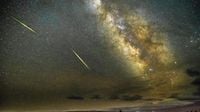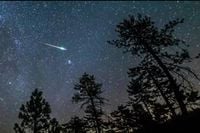The Eta Aquarids meteor shower, formed by fragments of Comet Halley, will peak this week and can be observed more intensely in the early hours of Tuesday, May 6, 2025. According to the National Observatory, conditions are favorable for monitoring the phenomenon, especially in areas further away from urban lighting.
The best time to observe is between 2 AM and 4 AM, looking east. Until May 6, 2025, the Moon will not interfere with visibility, but from May 7, 2025, the lunar clarity may make it difficult to view the meteors. In the Northern Hemisphere, the estimated number of meteors per hour ranges from 10 to 15 in ideal conditions, while in the Southern Hemisphere, especially in tropical areas, observation is even more favored.
The fragments come from Comet Halley, which passes through the Solar System every 76 years. It was last seen in 1986 and will return to the inner Solar System in 2061. The Eta Aquarids are linked to this famous comet, as the Earth crosses the trail of debris it leaves behind.
According to astronomer Dr. Marcelo de Cicco, coordinator of the Exoss project, observers should ideally find a dark location, away from city lights, to fully enjoy the celestial display. The best viewing conditions will allow for up to 60 meteors per hour in the Southern Hemisphere, particularly in Brazil, where the radiant—the point from which the meteors appear to originate—will be higher in the sky.
To enhance the viewing experience, it is recommended to lie back in a reclining chair or on a flat surface and gaze at the sky. The time it takes for the eyes to adjust to the darkness can take between 15 to 20 minutes, so patience is key. Weather permitting, this should provide a stunning view of the meteor shower.
As the Earth travels through the debris trail left by Comet Halley, the meteoroids—ranging from tiny grains of dust to larger pebbles—enter the atmosphere at high speeds, generating the luminous streaks known as meteors or “shooting stars.” Each meteor from the Eta Aquarids is essentially a tiny fragment of the comet burning up in the atmosphere.
In addition to being a spectacular visual event, meteor showers like the Eta Aquarids are of significant scientific interest. They help researchers estimate the volume and frequency of space debris entering Earth’s atmosphere, which is crucial for protecting satellites and space missions. Furthermore, studying the composition of meteors can provide insights into the formation of the Solar System.
Other meteor showers expected in 2025 include the Alpha Capricornids, active from July 3 to August 15, with a peak on July 30; the Delta Aquarids, from July 12 to August 23, also peaking on July 30; and the Perseids, which will peak on August 12 with an impressive rate of up to 150 meteors per hour. The Orionids will be active from October 2 to November 7, with a peak on October 22, while the Taurids will have their peak on October 10.
In the realm of astronomical events, 2025 also promises three supermoons on October 7, November 5, and December 4, which occur when the full moon coincides with its closest approach to Earth, making it appear larger and brighter in the sky.
For those unable to view the meteor shower in person, many scientific institutions, including the National Observatory, often provide live streams of such events, allowing enthusiasts to witness the beauty of the cosmos from the comfort of their homes.
The Eta Aquarids meteor shower is not just a beautiful spectacle; it’s a reminder of the ongoing dance of celestial bodies in our universe. As the Earth moves through the remnants of Comet Halley, stargazers around the world will have the opportunity to witness a piece of history as they look up into the night sky.



